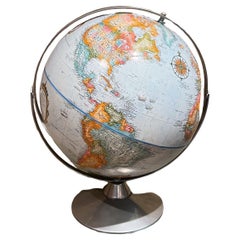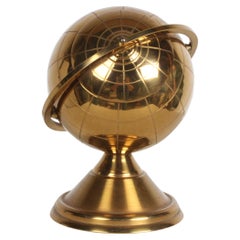Globes
Early 18th Century Dutch Dutch Colonial Antique Globes
Hardwood, Paper
18th Century Italian Antique Globes
Walnut
1960s American Mid-Century Modern Vintage Globes
Metal
Mid-18th Century British Dutch Colonial Antique Globes
Other
1960s American Mid-Century Modern Vintage Globes
Brass, Metal
1960s German Mid-Century Modern Vintage Globes
Metal
1960s American Mid-Century Modern Vintage Globes
Wood
Early 18th Century Dutch Dutch Colonial Antique Globes
Other
Early 18th Century German Baroque Antique Globes
Other
1710s German Dutch Colonial Antique Globes
Other
18th Century Dutch Dutch Colonial Antique Globes
Other
17th Century European Dutch Colonial Antique Globes
Other
1960s American Mid-Century Modern Vintage Globes
1790s English Antique Globes
Shagreen
1960s British Mid-Century Modern Vintage Globes
Chrome
1960s Art Deco Vintage Globes
Paper
1790s English Regency Antique Globes
Mahogany
1960s Italian Vintage Globes
Wrought Iron
1960s German Mid-Century Modern Vintage Globes
Wood
1960s German Bauhaus Vintage Globes
Glass, Wood
1960s American Mid-Century Modern Vintage Globes
Brass
Late 18th Century English George III Antique Globes
Shagreen, Paper
1770s English George III Antique Globes
Wood
1960s Vintage Globes
Metal
1960s American Arts and Crafts Vintage Globes
Brass
Mid-18th Century Swedish Rococo Antique Globes
Brass
1960s American Mid-Century Modern Vintage Globes
Aluminum
1750s English George II Antique Globes
Shagreen, Paper
Mid-18th Century American Antique Globes
Fruitwood
1730s French Antique Globes
Beech
Late 18th Century English George III Antique Globes
Wood, Paper
Antique, New and Vintage Globes
Antique and vintage globes can prove unique and interesting accents to your living space, whether on their own as provocative conversation pieces or part of a small collection dotting the shelves where your sculptures and other decorative objects live.
Globes are among the most ancient of scientific instruments. During the Age of Exploration, they were vital for navigation, bringing sailors home after perilous journeys on different trade routes. Globes didn’t just detail continental formations, they might also show astronomical positions — adventurous seafarers of the day would rely on stars’ positions in traveling the great waters ahead of them. Antique globes offer a glimpse into specific time periods and how peoples of the past navigated the world around them. These were tools that identified a region’s borders, the names of countries, territories and more as the Earth’s geography was once known or imagined. As information about a place became available to geographers over time, globes became more accurate.
Not all globes depict the Earth and its countries, landmasses and bodies of water. The models that do are known as terrestrial globes, while globes that detail the position of the stars and other heavenly bodies are called celestial globes.
Quite surprisingly, the construction of globes remains relatively unchanged from the 16th century. The base starts as two papier-mâché hemispheres, which have a wooden support pillar attached via the north and south poles. The hemispheres are joined with glue or sewn with string and are subsequently topped with more paper or even thin fabric. Lastly, the globe is covered with plaster, ready for the design to be pasted on top.
Perhaps even more surprising is that the decorative function of globes has not changed much since the 16th century. They’ve been given as gifts for hundreds of years, as globes have always been beautiful objects whether they’re in your home office or your living room, lining your mantel alongside other globes of different sizes. Recent globe designs offer modern variations in style and features, such as interior lighting, automatic rotation and more.
Today, vintage trunks and luggage have reappeared as furniture or decorative home accents in a bedroom or foyer. This likely owes to wanderlust, nostalgia and a shared love of good design. Decorating with globes is similarly rooted in the allure of travel and a penchant for the stylish finishing touch that collectibles bring to our homes. Antique globes add welcome doses of color and contrast to a house or apartment’s neutral corners, their sea blues and algae greens popping against reclaimed wood interiors or stone fireplaces.
On 1stDibs, you can find a collection of authentic antique and vintage globes including mid-century modern, Georgian, Art Deco editions and more.





